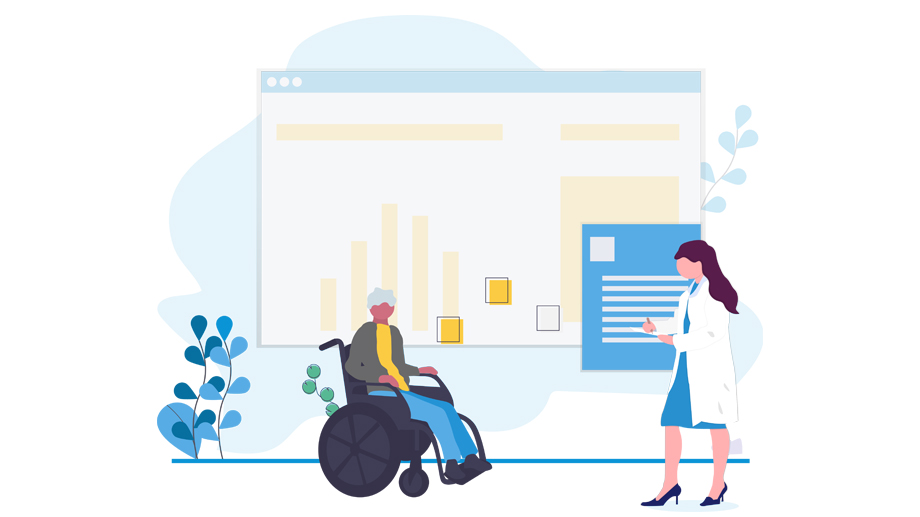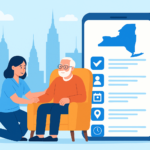Home healthcare businesses face unique challenges like fraud claims, care coordination, and complex scheduling requirements. Along with it, they also operate on razor-thin margins because of the nature of their business. Electronic Visit Verification (EVV) is a method introduced for the U.S. healthcare industry to overcome these challenges. It digitally verifies and documents the delivery of home and community-based services (HCBS).

Research forecasts the home healthcare industry to grow at a compound annual growth rate (CAGR) of 7.96% from 2024 to 2030.
With the increase in demand for home healthcare, EVV is the need of the hour. Adopting new practices and technologies can be a challenge, and EVV is no exception.
Most providers offer automation for field operations. It helps address the complex logistical challenges of managing caregivers, and improve profit margins and meet compliance requirements.
In this blog post, we discuss some key details about EVV implementation and how it can be a game-changer for your business. But first, let’s explore what is EVV in healthcare?
What is EVV?
Electronic Visit Verification (EVV) uses advanced information technology to digitally capture and verify the delivery of home healthcare services as scheduled. EVV systems track and document key details of care visits, such as the date, time, location, and services provided. Aggregators like HHAeXchange and Sandata then record this information in a centralized database.
This helps ensure accountability, compliance with care standards, and the prevention of fraudulent activities.
- Verification of Service Delivery: EVV enables the electronic verification of service delivery to ensure accuracy. It plays a critical role in preventing medical malpractices such as billing or other fraud.
- Digital Records: EVV aids in making all medical records digital. This minimizes reliance on paper-based documentation, reducing the risk of theft or misplacement, and safeguards patient data.
- Security & convenience: The system is designed to accommodate home care agencies of all sizes. It offers a secure way to collect and verify patient visits and care, enhancing accountability and service delivery standards.
Is EVV required for Medicare?
Yes, EVV is required for Medicaid.
According to the 21st Century Cures Act, states that fail to implement EVV will face reduced federal Medicaid funding. As of January 1, 2021, all Medicaid-funded personal care services must utilize an EVV system.
Home care agencies providing these services must have an EVV solution in place to avoid denied Medicaid claims. Additionally, all personal care services and home health visits reimbursed by Medicaid or Medicare must meet EVV requirements. Consult your state’s Medicaid website to review the specific programs that mandate compliance.
How does EVV work?
Recording Visit Details: Caregivers use a mobile app or interactive voice response (IVR) technology to log key information about each visit. It typically involves recording of:
(i) Type of service delivered;
(ii) Person receiving the service;
(iii) Date & time of the service;
(iv) Location of service delivery;
(v) Individual providing the service
Confirming Visit Location: Location-based technology (such as geofencing) can verify caregivers’ presence. The system records and reports any discrepancies to the office in real time.
Sending Data for Claims: The system sends the visit verification data to an aggregator, which then forwards it to Medicaid. This data provides necessary documentation to support claims and ensure compliance.
Visit Verification Methods
The 3 most common ways to record visiting details-
1. Mobile Application: Caregivers can download your chosen vendor’s app, like allGeo, on their smartphones. It captures service periods and GPS-based location data. These apps often include additional features like scheduling, routing, and more.
2. Telephones: Using IVR, caregivers can call a designated number to clock in, select the services provided and to clock out. While easy to implement, this method is vulnerable to service disruptions and potential fraud.
3. Visit Verification Device: This method requires installing a small device in the patient’s home that displays a code and changes every minute. Caregivers record the code upon arrival and departure, then log both codes into the EVV system later. While less commonly used, it offers a simple solution for verifying visits.
What Challenges Does EVV Solve For Field Caregivers?
You can enhance your caregivers’ experience with automation. Advanced software solutions help overcome the logistical challenges of workforce management along with EVV compliance.
These include features like route optimization, mileage tracking, automated scheduling etc. You can remain compliant, and also improve workflow efficiency.
Then, how does EVV software benefit caregivers? To understand this, let us look at some of the challenges faced by them-
Optimized Scheduling and Time Management
Automated EVV systems use intelligent scheduling algorithms to assign visits based on caregiver availability, location, and workload. Therefore, it leverages the same data used for visit verification to optimize scheduling.
This automation reduces the likelihood of double-bookings or inefficient travel routes, saving time and minimizing caregiver fatigue.
Enhanced Safety and Accountability
A centralized EVV platform collects caregivers, office staff, and patient schedules data in one place. It digitally verifies visits using GPS and/or timestamp field data such as signatures or selfies.
This automated verification thus meets regulatory compliance, and also provides safety assurance to caregivers. The system monitors and logs their location and activity in real time. Alerts and notifications can quickly signal if there are discrepancies or safety concerns.
Reduced Documentation Burden
Automation eliminates the manual recording of visit details. It automatically logs time, attendance, and the type of care provided. This reduces the paperwork burden on caregivers and enhances accuracy, allowing them to spend more time on patient care. Electronic documentation also minimizes errors and prevents issues like lost or misplaced paperwork.
How to Implement EVV for Home Care?
If you’re wondering how to implement an EVV system for care providers, there are many aspects you need to consider. There isn’t a “one-size-fits-all” model for the implementation of this system.
Each state has a different model. For example, some states allow home visits while others do not. In addition, some states only allow paper-based data collection while others allow either one or both.
1. Understand Your State’s EVV Requirements & Vendor Model
- Identify Your State’s Vendor Model: Implementation is relatively straightforward when your state uses the state-mandated vendor model or MCO choice model. The same is not true if your agency uses another type of contract or you want a custom solution.
- Know Your Implementation Deadline: Understand your state’s timeline for implementing EVV to avoid noncompliance penalties.
2. Choose the Right Vendor
- State-Mandated Vendor: Using the state-provided system is often the simplest option since it’s compliant, free, and meets all technical requirements.
- Independent Vendor Selection: If you can choose your EVV vendor in your state, decide between using an existing system or a custom solution.
- Buying an Existing System: Faster and more cost-effective, with established compliance and functionalities.
- Building a Custom System: allGeo offers a custom solution to tailor features beyond mandate requirements for workflow automation.
- Buying an Existing System: Faster and more cost-effective, with established compliance and functionalities.
3. Choosing a Data Collection Method
Data collection for your state-specific campaign can be simple, using methods like a mobile app or IVR systems. Many different data collection methods are available depending on the laws in your state.
4. EVV training for your organization
- Cover Basic Requirements: Explain federal and state mandates, consequences of noncompliance, and key regulations.
- Highlight the Benefits: Discuss fraud prevention, increased productivity, streamlined claims processing, and enhanced fuel reimbursement.
- Discuss Privacy and Security: Clarify GPS tracking and other security features to eliminate confusion and address concerns.
If you’re using state EVV, the state provides the necessary training. However, if you choose a vendor like allGeo, they handle all the training, rules, and regulations.
5. Overcome Common Implementation Challenges
- Device Management and Security: Implement a clear policy for corporate or BYOD devices, and establish procedures for maintaining security and data integrity.
- Build Trust with Workers: Clearly explain privacy, monitoring policies, and the system’s benefits for caregivers and clients.
- Technical glitches: Issues related to software and hardware can prevent caregivers from doing their job well. Provide accessible tech support across multiple channels such as phone calls, chats, or email.
- Data privacy: HIPAA compliance requires caregivers to enter sensitive patient information, such as social security numbers, raising privacy concerns. Since healthcare records are crucial for compliance, it’s vital to choose a provider with a strong privacy policy.
Conclusion
EVV has drastically transformed the home healthcare industry. This system now enables agencies to verify that services were provided. Similarly, caregivers can provide proof-of-service for reimbursements or timely payment.
Overall EVV has improved the quality of home health care while also reducing costs. For home healthcare providers and agencies, implementing an EVV system is a smart business move. Consider a free trial to witness the benefits.



